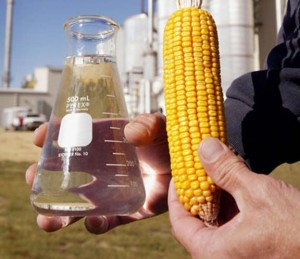Only months ago, the EPA was pressing hard to expand the use of ethanol in the nation’s gasoline supply, but in the wake of this summer’s fierce drought, the agency may soon reverse course and actually trim back because of shortages of corn used to produce the renewable fuel.
Senator Orrin Hatch, an influential Utah Republic this week urged the EPA to curb ethanol requirements, as have 200 members of the House and the governors of eight corn-producing states. Under a 2007 law signed by former President George Bush, 15.2 billion gallons of ethanol would need to be used this year, with the plan to more than double that by 2022.
But the viability of that plan came under sharp inspection when, yesterday, the U.S. Department of Agriculture forecast a sharp decline in farm grain output predicting next year’s global corn stockpiles will 5.4% – to the lowest levels in 39 years. The USDA warned that only 23% of American corn crop yields are in “good” or “excellent” shape compared with 70% last year.
That sent prices for corn spiraling upward. Hatch and others are hoping that by at least reducing the potential demand for corn stocks for fuel use demand prices may level off – which could, in turn, prevent a spiral driving up overall U.S. inflation rates.
“In the face of corn shortages and escalating prices brought on by wide-spread droughts throughout the United States, I urge you to exercise your waiver authority to modify the corn-ethanol requirements for the Renewable Fuel Standards,” Hatch wrote in a letter to EPA administrator Lisa Jackson.
Ironically, Hatch and others now calling on the EPA to back off on ethanol usage were proponents of the 2007 Energy Independence Securities Act – which was aimed at both reducing dependence upon foreign oil while also propping up American farmers by mandating more use of renewable fuels.
When passed, the EPA was expected to direct 5 billion of ethanol into the fuel supply for 2007, but the sliding scale reached 15.2 billion gallons this year. And it will peak at 36 billion gallons by 2022.
The law was designed to assuage skeptics who felt that even during good times on the farm too much corn would be diverted to fuel. By 2022, a full 21 billion gallons of ethanol are to come from so-called cellulosic production. While still in the development stage, new production facilities have turned to a variety of alternatives to corn, ranging from scrap paper to grain chaff that would normally not be used in the food supply.
Ironically, the EPA has been struggling to find ways to meet the mandate since consumer demand for ethanol has lagged expectations – even though subsidies keep the price per gallon below that of regular unleaded gasoline.
The agency has increased the amount of ethanol in use in regular gas. And it last year approved rules that would require the use of such fuel in older vehicles produced before the industry began upgrading their fuel systems to tolerate the use of alcohol-based fuels. Ethanol, like other alcohols, is highly corrosive and makers now use special stainless steel or modified synthetic fuel line and engine components to resist damage. Critics continue to dispute EPA claims that the recent increase in ethanol content will be safe for older cars and other products – from ATVs to chainsaws – that run on gasoline.
While a number of states are joining the call to reduce ethanol usage overall this coming year, including governors of Maryland and Delaware, where major poultry operations could be hard hit by rising cots – not everyone echoes that sentiment.
The Michigan Farm Bureau is opposing the request. Indeed, some farm states are hoping to see corn prices rise in the months ahead to help offset declining yields in their local crops that could put some farmers out of business. A report in the Detroit News noted that Michigan’s five ethanol refineries used 98 million bushels of corn annually – compared to a combined 70 million for livestock, dairy and poultry feed.
The EPA is expected to rule on the ethanol waiver request by early November.

